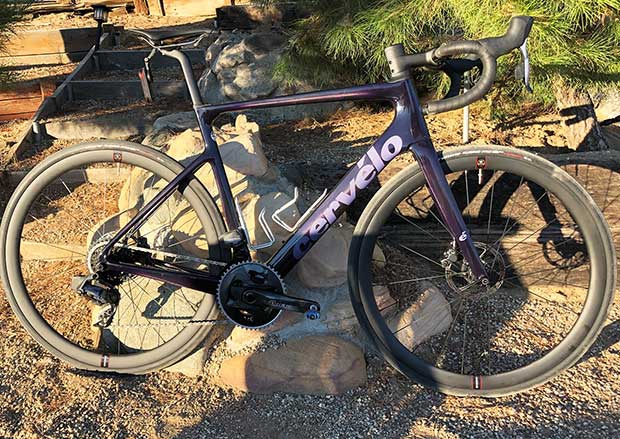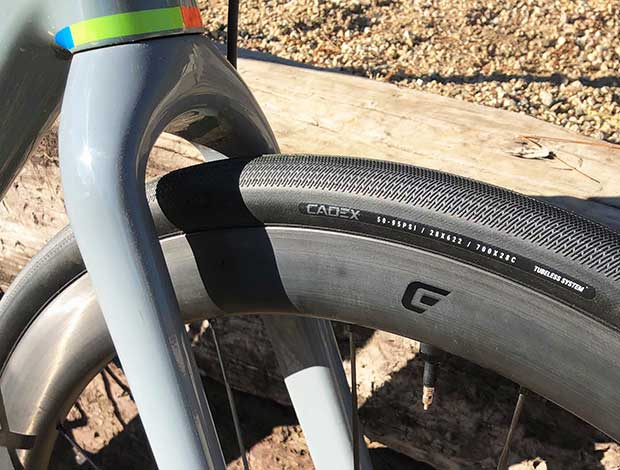Why the Caledonia’s Geometry is Revolutionary
It seems to me that Cervelo’s Caledonia signaled a change in bike geometry unlike anything that I’ve seen since the earliest days of my 40-plus years of cycling. (If I’m overstating this, I’m sure some of you will let me know.)
What is it that Cervelo did with this bike? I thought I’d see if I could show this graphically, via my bad artwork. Then explain why this is a big deal, and what this means for road bikes of the future.
Also, I’ll explain why today’s gravel bikes, not today’s road bikes (excepting the Caledonia), are actually built more in the way many of tomorrow’s road bikes will be built; and finally I’ll talk about how this new geometry changes what size of bike you may want to buy (in my case, the Caledonia changed me from size-58 in Cervelo road to size-56 in Cervelo road).
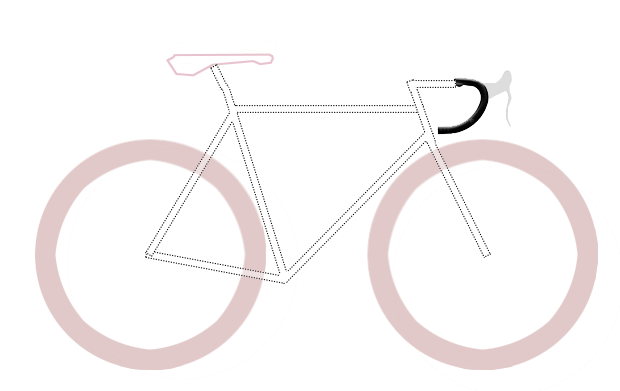
Bikes Above and Below the Waist
I created this vocabulary some years back; I’ve never heard anyone use it but me; so maybe it’s nonsensical and unnecessary. But I don’t know how better to say it. If you draw a horizontal line that passes through the bike in between the seat or down tube water bottle bosses, that’s the bike’s “waist.”
Almost every metric “above the waist” is bike position related. The frame’s stack and reach are the rise and run from the bottom bracket (where your crankset attaches to the bike) to the top of the head tube (that place in the circle in the image just below). This describes the length of the bike, and its height, for fit purposes. It does NOT explain the height of the bike, nor its length, for the purposes of handling, or pedaling clearance.
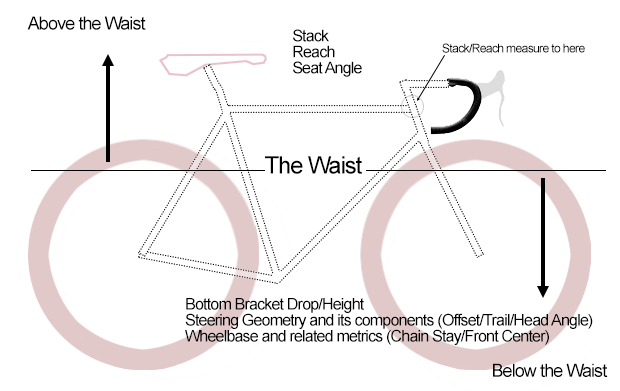
As you’ll see when you look at the graphics further below, it’s quite easy to change the length of the bike below the waist, but not change the length of the bike above the waist. For example, I have a RAM pickup. It’s called a longbox (or longbed). Were I to get that pickup in a shortbox, the driving compartment (the seat, the steering wheel, how I fit in the truck) would remain unchanged. But the truck “below the waist”, for example the truck’s wheelbase, could change considerably, without changing how I fit the truck, as a driver.
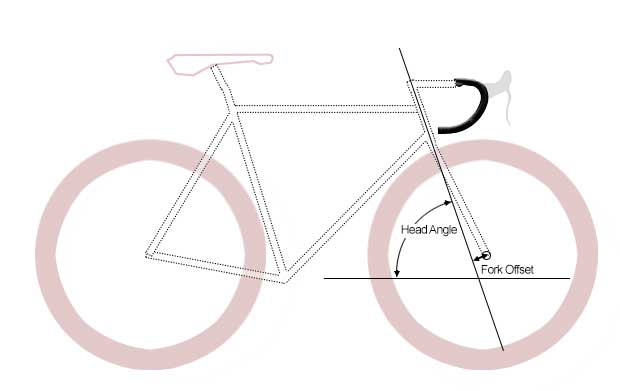
Front Center
If road bikes are “shortboxes,” what Cervelo did was make a “longbox” road bike. It lengthened the front center (aka, front/center, front-center, front:center) of the Caledonia. Without changing too much how the bike handles or fits.
"Front center" is the distance from the bottom bracket to the front wheel axle. Why would you make it longer? Why would you make this specific metric longer, and keep everything else the same? Three reasons (two of which have already been done, one of which is part of my ancient history).
Tri Bike Front Center:
When I made what is commonly referred to as the first dedicated “tri bike” (a geometry specifically for aerobars) there were two distinctive geometric changes from a road bike: seat angle (a much steeper seat angle); and a longer front center. Why? Me, all of us, want to ride our tri bike with our hips much further forward than we want to ride our road bikes. If we can stipulate to that, then, this is why the seat angle got a lot steeper. The front wheel needed to move forward as well, or else we’d end up with all our weight over the front wheel.
Small- and Gravel-Bike Front Center:
If you ride a gravel bike with a 700c wheel, and you ride a larger tire (say, 40mm, or 44mm) the “tire” radius is going to be gigantic. This extra tire radius bears on steering geometry; and in bottom bracket height; but it also impacts shoe overlap. That bigger radius doesn’t just impact steering geometry; it gives you a shoe-tire clearance problem unless you account for it in bike design. You must push that front wheel axle out further out.
Same thing for women’s bikes. For years “forward thinking” (ba dum tss!) companies like Cervelo have made women’s bikes that fit appropriately (that don’t make you reach into the next county to grab the handlebars); that preserve the bike’s trail (more on trail below); that use 700c wheels; and that don’t have shoe overlap. How? By adding fork offset along with shallowing the head angle. Look at Cervelo’s R Seres (standard road) geometry chart below. Look at how the trail remains the same, but in the smallest size these geometric changes happen. You can see what Cervelo felt was the smallest front center it wanted: about 575mm.
Below that, you risk shoe overlap. Note that in the smallest 3 sizes the front center stops scaling down. The “reach” continues to scale down, but front center does not. This is because each of the last 2 sizes uses a successively slacker head angle and successively greater fork offsets.
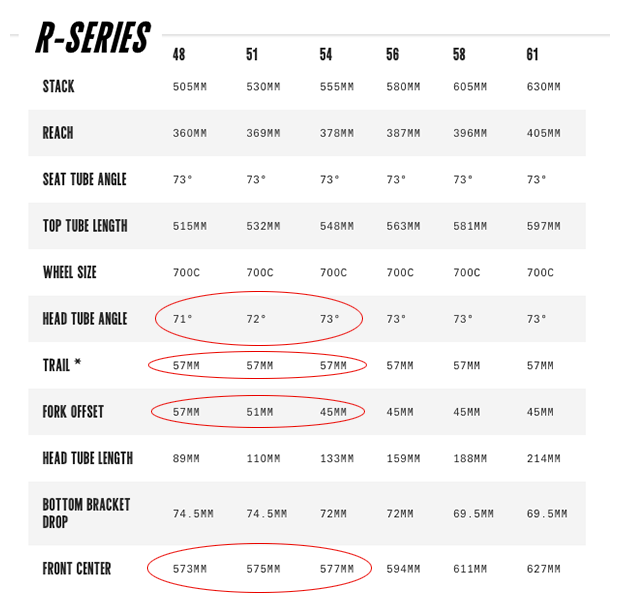
But the "trail" remains the same throughout that size run of Cervelo R series bikes, and that was a design imperative for Cervelo. What is trail? You can see it in the graphic just below. The “steering axis” is an imaginary line that runs right down the center of your fork’s steer column (the part of the fork that travels up through the frame). The contact patch of the tire is that point where the (front) tire contacts the ground. Let’s say you project the steering axis all the way to the ground. Here’s a pnemonic device for it: The bike’s “trail” is the amount that the contact patch of the tire “trails” the point where the steering axis would hit the ground (the projection of the steering axis). The more trail, the more the bike wants to self-center, i.e., wants to go in a straight line, wants to resist turning. The smaller the trail the more “lively” the bike handles. So, predictable or lively.
I’ve ridden really good, really nice handling, road bikes that have a trail of anywhere from 45mm up to 60mm. In general, bikes that are quick handling have a lower trail number (like, 53mm). Bikes that handle more slowly have a trail more like 58mm. There’s more to how a bike handles and steers, but let’s just leave it here for now.
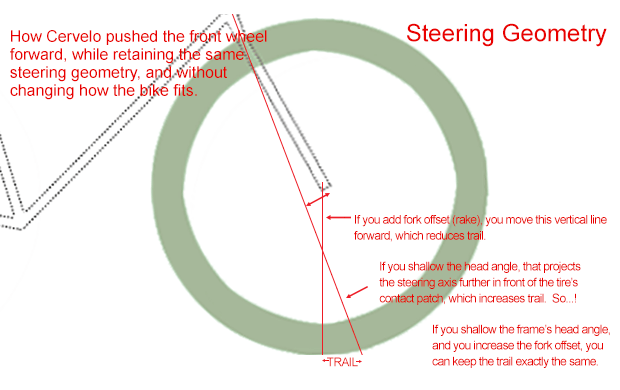
The only road bikes that ever got this “chopper” treatment – shallow head angle, lots of fork offset – are the old, old touring bikes from generations past. Typical road bikes, in mainstream sizes, had a front end of, say, 73° of head angle and 43mm of fork offset. Cervelo put a 72° head angle in its Caledonia with 50mm of offset. That just isn’t done to a road bike. Nope!
Why? It was a rather swashbuckling decision. The point was to stretch the bike out, add compliance, specifically for nasty pavement, cobbles, rideable dirt. Remember those old steel touring bikes I just mentioned? This is sort of what Cervelo made. Even though Cervelo added a lot of fork offset along with the shallower head angle, the bike still has a rather large 59mm of trail. But the darned thing works.
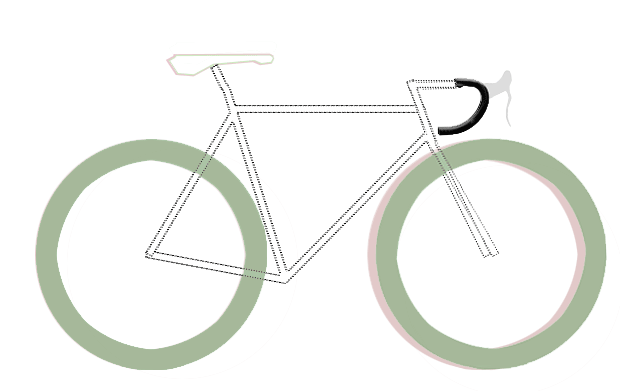
It may not look like much, but the drawing above shows what Cervelo did. The bike with the green wheels is the Caledonia, and it's laid over the R Series bikes Cervelo makes, and the main difference is the longer distance from the bottom bracket to the front wheel axle. See how the fit doesn’t change. And the trail doesn’t much change. Mostly it's the front center that changes. Whenever I write about “dual” or “multi” use bikes – gravel and road – this is also what these bikes do (for some different reasons).
What this means, among other things, is I can ride a Cervelo road bike again. Previously it was hard for me to do so, because the R Series made with the reach I want were too tall (the stack was too big).
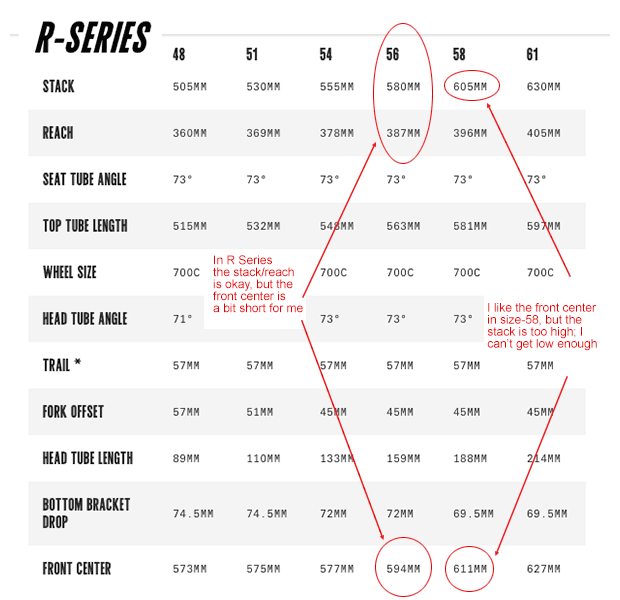
If were to look at the geometry chart for the Caledonia, you’d see that the bike in size-56 fits exactly like Cervelo’s R-Series road bikes fit. So, I still can't ride it, right? Well, instead of that 594mm front center that you see for the 56cm R Series, the Caledonia's is 608.5mm, almost as long as the front center in the 58cm R Series bikes. That means the 56cm Caledonia works great for me, because, below the waist, it's a "longbox." In fact, because of a rather longish chain stay in the Caledonia, the size-56 in that bike is actually 1mm longer than in the size-58 in the R Series (1012.3mm versus 1011mm).
This makes the Caledonia sort of a two-fer. If you need that taller stack you can have it, you just will have a longer wheelbase than you're used to. If you need a lower height, the longer front center and wheelbase allow you to ride a size down, which is what I do.
If you’re unsure whether this geometry has utility in a road bike, okay. But then I don’t want to hear you talk about your multi-use gravel/road bike! Below are some select metrics; I’d have given you more if the bike brands had given more to me (3T is a little selective on what it offers on its geometry charts). But I think you can see how close these bikes are one to another.
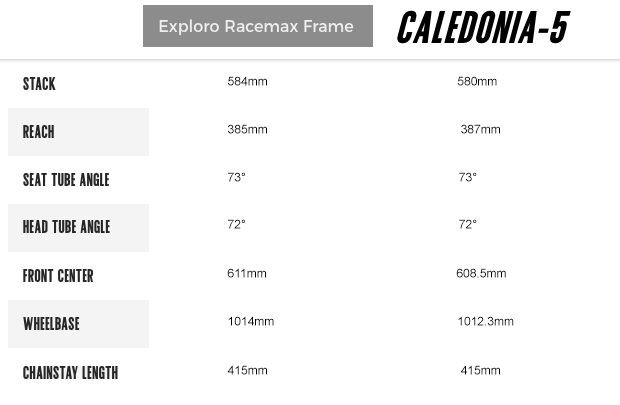
Point being, like with sheriffs, there’s a new geometry in town. The Cervelo Caledonia is not a gravel bike, but it is very similar to today’s gravel geometry. The reason for that gravel geometry has – my guess – more to do with tire clearance, and for shoe overlap, than for handling. But the by-product of this geometry is comfort, stability.
The takeaway – why I think the Caledonia is significant, beyond its other virtues – is that it introduces a gravel geometry front end (72° head angle, 50mm fork offset) to road race bikes (in sizes all the way up and down the size chart; not just for small- and women’s-sized bikes). It’s for sure a race bike. It’s the classics bike for its pro tour team. However, any bike good for a 7-hour race on cobbles is also a bike good for those of us who want a certain, predictable, comfortable road bike. In other words…
It’s a road race bike that’s also a lifestyle bike. For a long time now the bike industry has given us upright geometry. Tall geometry. “Endurance” or “gran fondo” geometry. It’s decided that hiking the front end up, and giving you a bike that feels like you’re riding a Lay-Z-Boy recliner chair, is what you need. Piffle. The Caledonia is a comfortable bike in a performance geometry, and way, way, way too many of you are riding endurance geometry because whomever prescribed your position (bike fitter or bike salesman) was timid, and did not allow you the opportunity to ride in the most effective position available to you.
It is my guess that the Cervelo Caledonia is a premier Paris Roubaix bike. But if you look at the aerodynamics and geometry of a 3T Racemax then it – though a gravel bike – would do quite well in that same race, if outfitted with road race wheels. This is a new, vibrant, road geometry, whether designed into a road-specific bike, like the Caledonia, or a multi-use bike like the Racemax when it’s set up with road wheels. My OBED Boundary has almost the same geometry; my OPEN WI.DE has almost the same geometry.
This may not be the criterium geometry of the future, but you’re going to start to see this geometry in a lot of road bikes, I predict, and in a lot of performance gravel bikes that will transform into very fine road race bikes once you slot in a set of road wheels.


